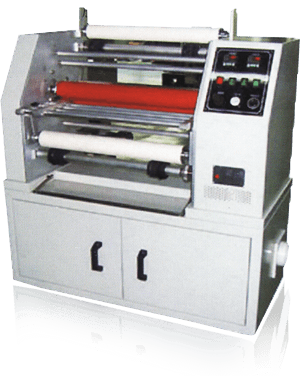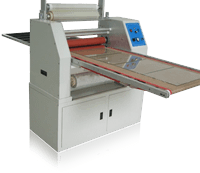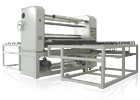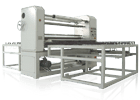General
It is a compact machine covered by sheet metal painted with top quality varnish and epoxy primer. The machine consists of inlet conveyor, film sticking section and outlet conveyor. Production procedure includes loading, inlet conveying, film unwinding, film applying, roller pressing, film affixing, film cutting and unloading.
Inlet Conveying
Glass is manually positioned on inlet conveyor in alignment with film. Glass is conveyed on rollers or castor ball manually towards film sticking machine. There are wheels on castor balls tables. It could be removed away when necessary. This design allows easy access close to film sticking section when films replacement or maintenance.
Dust Removing
This section locates right before applying and sticking section. Dust removing is achieved by adhesive rolls or anti-static devices depending on models.
Adhesion
Special adhesive rubber rollers and adhesive paper rolls are installed in the machine. When glass passes through adhesive rubber rollers, glass gets in contact with adhesive rubber rollers. Contaminations on glass surfaces are stick on adhesive rubber rollers. When adhesive rubber rollers rotate, contaminations are then transferred to adhesive paper rolls. When adhesive paper rolls become dusty or no more suitable for dust remove, it is unroll manually, usually one round, until fresh adhesive surface exposed. Unroll paper is trim and fresh adhesive surface is ready to use.
Anti-Electrostatic
Alternatively, machine could be installed with a device which blows air via air knife to eliminate anti-electrostatic accumulated on glass surface. Meanwhile, dust on glass surface is blown off. Air is generated by air compressor provided by buyer. Air, water and oil filters are also provided by buyer.
Film Applying & Affixing
Press Rolls
It is composed of heavy duty top and bottom press rollers across the structure. Top tangential surface of bottom roller is level with conveyor rollers. Press rollers are covered by abrasive resistant rubber. Rubber is hard enough to apply film on glass but meanwhile, it is elastic and soft not to scratch or damage the glass. Both top and bottom rollers are synchronized driven by electric motor regulated by frequency converter. Gap between top and bottom press rollers are adjustable according to glass thickness. While glass or mirror is drag forwards manually on inlet conveyor until it arrives at press rolls, it is pulled by motorized press rollers into the gap between top and bottom press rolls. Top roll laminates film on glass or mirror surface with bottom roller served as a back support.
Film Support
There is a tube above rubber rollers. Film roll is inserted into metal tube. There are two adjustable stoppers on the steel tubes. When film roll is loaded, stoppers moves against two ends of film roll. Stoppers are fixed with bolts to prevent film roll from sliding during operation.
Film Stretching Regulator
It is a metal bar, running with one way bearing, lying across the machine beneath film supports. Film is unwind from film support and is hung over across this bar and finally lays on glass or mirror surface. The bar is used to stretch the film and regulate film tension. It also acts as buffer. Uniform film tension ensures wrinkle free and perfect flatness of film lay on glass or mirror while passing through top and bottom rubber rollers.
Film Cutting
Film cutting is done manually. After glass, with film lay on top, exits from press rollers completely, film is manually cut at glass tailing edge.
Film Protective Layer Winding
Some films are surface protected with a thin layer. When film is applied on glass, this protective layer is no more necessary and it is peel off. This winding system is used to peel off and wind up the film layer when film is being applied on glass. When there is optional double sides film capability, the machine is equipped with two winding roll. One is at top for top protective layer winding while another at bottom for bottom protective layer winding.
Outlet Conveying
After film applying and cutting, glass is manually conveyed until end of outlet conveyor and it is ready for unloading. There are wheels on castor balls tables. It could be removed away when necessary. This design allows easy access close to film sticking section when films replacement or maintenance.




